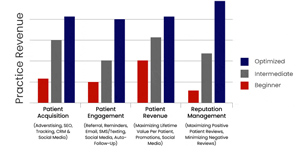Creating a Unique Selling Proposition (USP) for a medical practice marketing
A Unique Selling Proposition (USP) for a medical spa is a clear and concise statement that differentiates the spa from its competitors and communicates the unique benefits or value that it offers to potential clients. It focuses on the aspects of the spa that stand out in a crowded market, such as specialized treatments, exceptional customer service, or unique expertise. However, primary care is often seen as a commodity – routine checkups, basic illness treatment, and referrals. To differentiate, your USP needs to address common patient frustrations and highlight your unique advantages.
USP Examples for 1) Med Spa and 2) Primary Care Providers


How to define a USP for a medical spa
1. Identify the Core Values and Strengths of Your Medical Spa
- Expertise and Certification: Highlight the qualifications, certifications, and experience of your staff. For instance, if you have board-certified dermatologists, licensed estheticians, or specialists in advanced procedures like laser treatments or Botox, this can be a key differentiator.
- Cutting-Edge Technology: If your spa uses the latest, most advanced technology, such as laser machines, radiofrequency devices, or microneedling techniques, this can be a strong USP. Emphasizing non-invasive and pain-free procedures can appeal to clients looking for high-tech solutions.
- Tailored Treatments: Offering personalized, customized treatment plans based on individual skin types, concerns, and goals can set your medical spa apart. A focus on creating individualized experiences makes clients feel valued and understood.
- Holistic and Comprehensive Care: If your medical spa takes a holistic approach, offering services like NAD+ therapy, anti-aging treatments, wellness consultations, and stress reduction therapies alongside cosmetic procedures, this can appeal to clients looking for overall wellness, not just beauty treatments.
- Exceptional Client Experience: If your medical spa focuses on delivering a luxurious, relaxing experience with exceptional customer service, it’s important to emphasize this. A spa experience that goes beyond just the treatment itself and focuses on a comfortable, soothing environment can be a major draw.
2. Research Your Competition
Understand what other medical spas in your area offer and identify gaps or areas where your spa excels. Look at:
- What services your competitors provide.
- What makes your services unique or better than theirs.
- How you can offer a better client experience or more personalized care.
3. Focus on What Makes You Stand Out
- Differentiation: Your USP should emphasize the aspect of your practice that is different from your competitors. Whether it’s a unique treatment, exceptional results, unmatched expertise, or a luxurious atmosphere, you want to communicate how your medical spa is different from the rest.
- Emotional Connection: Address the emotional benefits your clients will experience—whether it’s boosted confidence, youthful vitality, or feeling rejuvenated. This emotional connection can resonate deeply with potential clients.
4. Keep It Simple and Clear
Your USP should be easy to remember and concise. It’s not enough to simply list services or benefits. Focus on a core message that clients can understand quickly and easily.
Example USPs for a Medical Spa
- “Advanced Aesthetic Solutions, Personalized for You”
Focuses on tailored treatments and advanced technology, highlighting both expertise and individualization of care. - “Beauty Meets Wellness: Transformative Treatments for the Body and Mind”
This emphasizes a holistic approach, appealing to clients who value both beauty and wellness in a single package. - “Where Science Meets Luxury: Results-Driven Treatments in a Spa-Like Atmosphere”
Combines cutting-edge treatments with a luxurious experience, appealing to clients who want both high-tech results and relaxation. - “Your Confidence, Our Commitment: Expert Skin Care for Every Age”
Focuses on personalized skincare expertise that supports clients throughout different life stages, from anti-aging to skin rejuvenation. - “Youthful Results, No Surgery: Non-Invasive Treatments for Lasting Beauty”
A great option if your spa focuses on non-surgical treatments like Botox, dermal fillers, or laser skin care.
Crafting Your USP
- What’s your niche? Are you focused on anti-aging, weight loss, skin rejuvenation, or wellness therapies?
- What’s your expertise? Are you known for advanced, non-invasive procedures, or do you offer something rare, like hair restoration or tattoo removal?
- What’s your service experience? Do you provide an exceptional luxurious spa experience, or do you emphasize a clinical approach?
Your USP should reflect what makes you different, why clients should choose you, and how your spa adds value. A strong USP for your medical spa is not only about what you offer but how you make your clients feel. Whether it’s through expert care, personalized attention, or the latest technology, ensure your USP communicates the unique experience and benefits that set you apart from the competition.
Defining a Unique Selling Proposition (USP) for a primary care practice, with examples.
Understanding the Primary Care Landscape:
Primary care is often seen as a commodity – routine checkups, basic illness treatment, and referrals. To differentiate, your USP needs to address common patient frustrations and highlight your unique advantages.
Common Patient Frustrations in Primary Care:
- Long wait times for appointments.
- Short, rushed appointments.
- Difficulty getting in touch with the doctor or staff.
- Lack of personalized care.
- Limited access to after-hours care.
- Difficulty navigating insurance and billing.
Applying the USP Framework to Primary Care:
- Understand Your Target Audience:
- Consider if you’re targeting families, seniors, young professionals, or a specific demographic.
- Example: Families might prioritize convenience and pediatric expertise. Seniors might value personalized attention and chronic disease management. Young professionals might seek online scheduling and efficient communication.
- Identify Your Strengths:
- Do you offer extended hours or weekend appointments?
- Do you have a dedicated patient portal for easy communication and prescription refills?
- Do you specialize in a particular area, like preventative care or chronic disease management?
- Do you have a team of highly experienced and compassionate staff?
- Do you offer house calls, or telehealth appointments?
- Do you have a in house lab?
- Do you have a nutritionist on staff?
- Analyze Your Competition:
- What are the other primary care practices in your area offering?
- Are they focusing on convenience, affordability, or specialization?
- Identify any gaps in their services that you can fill.
- Determine Your Core Benefit:
- How do you alleviate patient frustrations and provide exceptional value?
- Example: “We prioritize your time and well-being, offering convenient access and personalized care.”
- Craft a Clear and Concise Statement (Examples):
- Focusing on Accessibility:
- “We offer same-day appointments and extended evening hours, so you can get the care you need, when you need it.”
- “We provide 24/7 access to your doctor through our secure patient portal and telehealth services.”
- Focusing on Personalized Care:
- “We believe in building lasting relationships with our patients, providing personalized care and comprehensive wellness plans.”
- “We dedicate ample time to each appointment, ensuring you feel heard and understood.”
- Focusing on Specialization:
- “We specialize in preventative care for seniors, helping you maintain your health and independence.”
- “We are a family-centered practice, offering comprehensive pediatric care and support for parents.”
- Focusing on Convenience:
- “We offer in-house labs and pharmacies, providing one-stop convenience for your healthcare needs.”
- “Online scheduling, prescription refills, and communication make healthcare simple.”
- Focusing on integrated services:
- “We provide integrated primary care, nutritional counseling and wellness programs, under one roof.”
- Focusing on Accessibility:
Key Considerations for Primary Care:
- Building Trust: Primary care is built on long-term relationships. Your USP should convey trustworthiness and reliability.
- Convenience: Patients value convenience, so highlight any features that make your practice more accessible and efficient.
- Affordability: Address concerns about insurance and costs, if possible.
- Empathy and Compassion: Emphasize your commitment to providing compassionate and patient-centered care.
By carefully considering these factors, you can develop a compelling USP that attracts and retains patients in the competitive primary care market.

